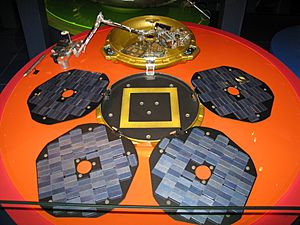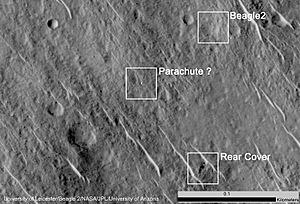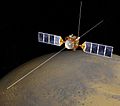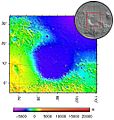Beagle 2 facts for kids

Replica of the Beagle 2 at the Science Museum, London
|
|
| Mission type | Mars lander |
|---|---|
| Operator | National Space Centre |
| Mission duration | 6 months (planned) |
| Spacecraft properties | |
| Landing mass | 33.2 kg (73 lb) |
| Payload mass | 9 kg (20 lb) science instruments |
| Dimensions | Folded: 1 m diameter Unfolded: 1.9 m diameter Height: 12 cm |
| Power | 60 W |
| Start of mission | |
| Launch date | 2 June 2003, 07:45 UTC |
| Rocket | Soyuz-FG / Fregat |
| Launch site | Baikonur Cosmodrome |
| Contractor | EADS Astrium |
| Mars lander | |
| Landing date | 25 December 2003, 02:45 UTC |
| Landing site | Isidis Planitia, Mars 11°31′35″N 90°25′46″E / 11.5265°N 90.4295°E |
The Beagle 2 was a British spacecraft. It was designed to land on Mars. The European Space Agency's Mars Express mission carried it to Mars in 2003. Its main goal was to search for signs of past life on the Martian surface. This type of mission is called astrobiology.
A group of British scientists came up with the idea for Beagle 2. Professor Colin Pillinger from the Open University led this team.
The spacecraft reached Mars orbit on December 19, 2003. It was set to land on Mars on December 25. But no one heard from it at the expected landing time. The European Space Agency (ESA) tried to contact it many times. In February 2004, ESA announced that the mission was lost.
Finding Beagle 2
For many years, no one knew what happened to Beagle 2. Its fate was a mystery. Then, in January 2015, scientists found it. Images from NASA's Mars Reconnaissance Orbiter helped them. This orbiter has a special camera called HiRISE.
The images showed Beagle 2 on the surface of Mars. They suggested that two of its four solar panels did not open fully. This problem likely blocked the spacecraft's radio antenna. Because of this, Beagle 2 could not send signals back to Earth.
Why the Name Beagle 2?
The Beagle 2 spacecraft was named after a famous ship. This ship was called HMS Beagle. It was used by the famous scientist Charles Darwin. He sailed around the world on this ship. He studied many plants and animals. His work helped us understand how living things change over time.
Images for kids
-
Model of the Beagle 2 at the Spaceport museum in Seacombe, Merseyside. It shows the spacecraft as it was found in 2015.
-
Beagle 2 launched with Mars Express. It separated near Mars after a long journey from Earth. Mars Express is still active in Mars orbit today.
See also
 In Spanish: Beagle 2 para niños
In Spanish: Beagle 2 para niños







